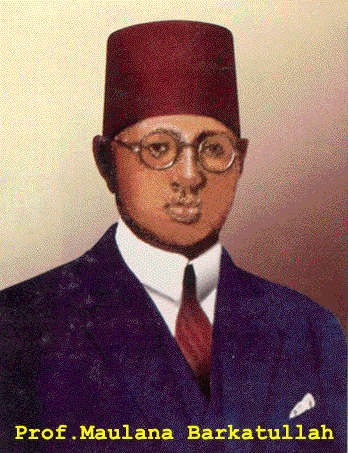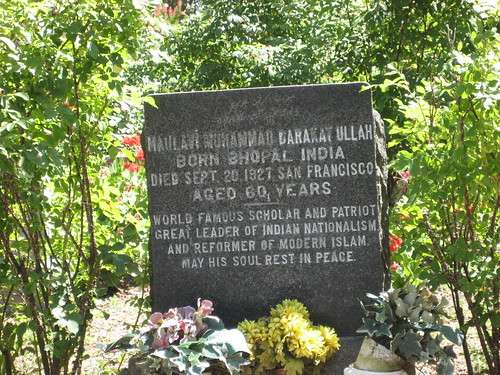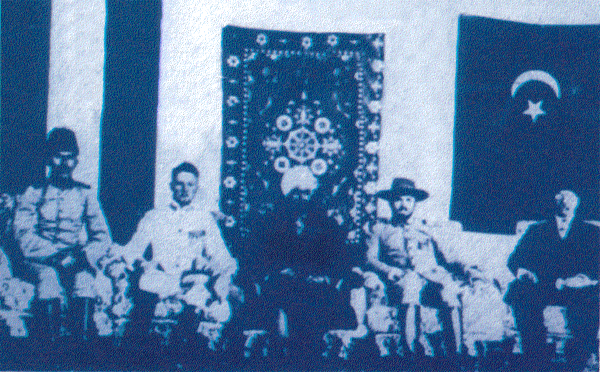By Ayub Khan, TwoCircles.net
TwoCircles.net presents “The History Column.” This fortnightly column features narratives, incidents, stories, from the past and not so recent past of Indian Muslim history. Columnist Ayub Khan is a student of history and Political Science.
It was a hot summer night in 1927. An elderly and weak looking man entered a community hall in Marysville, California. The gathered crowd of over 800 Indians became ecstatic and greeted him with a thundering applause. Strings of sparkling tears rolled down the face of the elderly man. He went up to the stage and began speaking with his usual forceful delivery but suddenly stopped. He couldn’t utter a word. There were wails and sighs from the audience. The elderly man composed himself and smiled; it’s glow sent a cheer through the audience. But he did not speak.

Maulana Barkatullah
A voice that has shaken the corridors of British colonial authorities was soon going to be silent forever. This voice belonged to the great, but almost forgotten, hero of Indian independence movement Maulana Barakatullah Bhopali. Maulana Bhopali’s life is one full of dedication and service-a fiery journalist, a brilliant orator, an erudite Islamic scholar, a nationalist to the core, an author of several books, a polyglot who knew more than seven languages, a prime minister of India’s government -in-exile. He was all this and more.
Maulana Barakatullah passed away on his way to San Francisco on September 20, 1927 and was buried in the Old City Cemetery of Sacramento. His funeral was attended by Indian Americans of all religious persuasions and they hoped that the Maulana’s remains would eventually be transferred to India once it attains independence. But, alas, the wish remained unfulfilled and the Maulana rests in peace in a particularly beautiful section of this historic cemetery.

Headstone of Maulana Barakatullah’s grave in Sacramento Historic Old City Cemetery (Courtesy: Sharon Patrician)
Maulana Barakatullah Bhopali was born somewhere between 1859 and 1861 in the princely state of Bhopal in India. His father Maulvi Muhammad Shujaat Ullah was a Madrassa teacher originally with meager resources and income. A bright student Barakatullah successfully completed his religious education at Madrasa-e-Sulaimaniya and qualified as an Alim in 1878. He served as a teacher at the same school from 1879-1880. He was able to utilize the intellectual milieu of princely Bhopal and was likely to have come in contact with the scholar-prince Nawab Siddiq Hasan Khan Qanauji. He is also reported to have met the pan-Islamist and reformer Jamaluddin Afghani in 1882 and was much impressed of his ideas.
In 1883 he disappeared mysteriously from Bhopal and ended up in Bombay where he enrolled himself in Wilson High School in Khetwadi. Despite being a mature student he did not mind attending the elementary grades. At the insistence of a certain Mr. Scot he began taking private lessons in English from him in return for teaching Urdu. Within three years he was proficient enough to qualify for the university entrance examination.
He went to London in 1887 and served as a private tutor teaching Arabic, Persian, and Urdu. He himself learned German, French, and Japanese. He was invited by the British convert Abdullah Quilliam to work at the Muslim Institute in Liverpool in 1895. He subsequently taught at the Oriental College of University of Liverpool. He later distanced himself from the Muslim Institute over its style of functioning.
While in England he came into contact with Indian revolutionaries at India House. In response to the then British Prime Minister Gladstone’s racist comments about India he launched a flurry of articles and speeches criticizing the policies. As a result his activities were severely restricted.
He left for New York in 1899 at the insistence of Muslim scholar and activist Muhammad Alexander Russell Webb. In his six year stint in New York he churned out a prolific number of articles related to Islam and India which were published in Webb’s The Muslim World and also in mainstream newspapers such as the Forum. To earn an income he taught Arabic. He developed contacts with the Indian community in other cities of US and Canada and sought to instill the revolutionary spirit in them. While in America he kept in touch with fellow revolutionaries in India and had a scholarly exchange with the poet and nationalist leader Maulana Hasrat Mohani. In these letters he stressed on the need for Hindu-Muslim unity in the freedom struggle. He became a founder member of the Ghadr Party started by the Indians in San Francisco.
Maulana Barakatullah reached Japan in 1909 and was appointed a professor of oriental languages at the University of Tokyo. He brought out a journal The Islamic Fraternity which was known for its anti-colonial content. After its suppression he brought out another newspaper by the name of El Islam which was banned in British India. As a result of his activities his appointment at the university was terminated in 1914. This, however, did not unnerve Maulana Barakatullah. He treated the world as his playground and moved his activities elsewhere.

Maulana Barakatullah (extreme right) with the Turko-German Mission.
He accompanied the Turko-German Mission to Kabul in 1915 and joined Maulana Ubaidullah Sindhi and Raja Mahendra Pratap to form the Provincial government of India. He served as the Prime Minister of the government-in-exile. In 1919 he met Lenin and sought his help in India’s struggle for freedom. Throughout the the early 1920s he travelled widely in Germany, France, and Russia organizing the expatriate Indian communities on the revolutionary path.
His 1927 visit was his second one to the New World and would prove to be his last. He was suffering from diabetes and had a host of other ailments but his love for the nation was such that he undertook the long journey from Germany along with long time friend and fellow revolutionary Mahendra Pratap. He arrived in New York in July 1927 and stayed at a hotel in Times Square. On 15th July 1927, he was given a reception by the Indian community at Ceylon Indian Inn on 49th Street. He also met the Pan-Africanist Marcus Garvey, founder of the Universal Negro Improvement Association and African Communities League. The two also spoke at a joint gathering of African-Americans and Indians. He also travelled to Chicago, Gary, and several other cities of the Midwest renewing his links with the Indian and Irish communities among whom he had many friends.
He arrived at the Yugantar Ashram, the Ghadr Party’s headquarters in San Francisco and was pleased with its work. He then proceeded to Marysville where he was destine to give his last public speech. Throughout this trip his constant companion was Raja Mahendra Pratap who was himself not keeping well and aging. According to Mahendra Pratap’s autobiography the Maulana last words were: “I have been sincerely struggling all my life for the independence of my country. Today, when I am leaving this world, I have regret that my attempts did not succeed. But at the same time I am also satisfied that hundreds and thousands of others have followed me who are brave and truthful…With satisfaction I place the destiny of my beloved nation in their hands.”
Maulana Barakatullah Bhopali was an epitome of sincerity and dedication towards one’s nation. A die hard to the core he never married as he considered it be distracting from his duty to the freedom struggle. It is an irony that this legendary son of the Indian freedom movement is reduced to the margins of Indian history. His name doesn’t find a mention in the country’s text books nor does his portrait grace the famed halls of the Indian parliament. There is, however, a university named after him in his native Bhopal.
Maulana Barakatullah’s sojourns in America also testify to the long standing links which Indian Muslims have maintained with the new world. Contrary to popular perceptions Indian Muslims did not begin arriving in America in the 1960s but at least sixty years earlier. The registers of cemeteries across California will verify this fact.
Maulana is buried at Old City Cemetery (http://www.oldcitycemetery.com/) of Sacramento, his grave is in Section A50.
Map of the cemetery: http://maps.google.com/maps?f=q&source=s_q&hl=en&geocode=&q=Old+City+Cemetery+Committee&sll=38.566824,-121.493168&sspn=0.015905,0.038581&gl=us&ie=UTF8&t=h&z=15
View Larger Map

